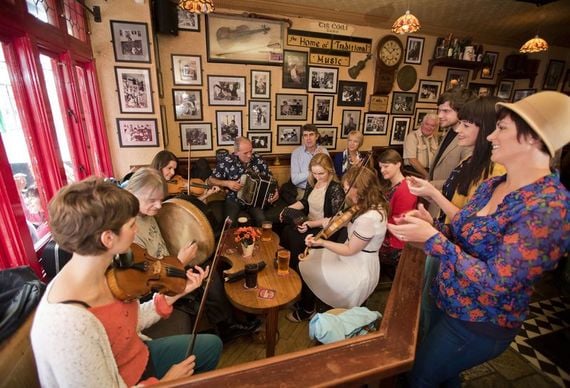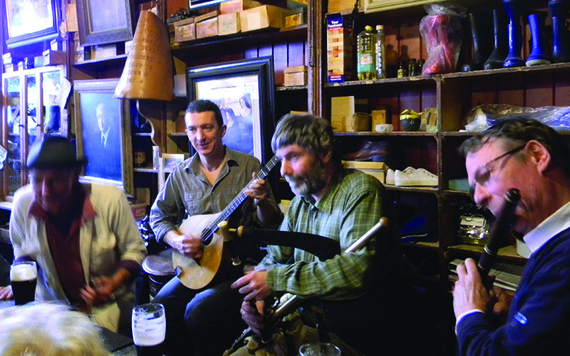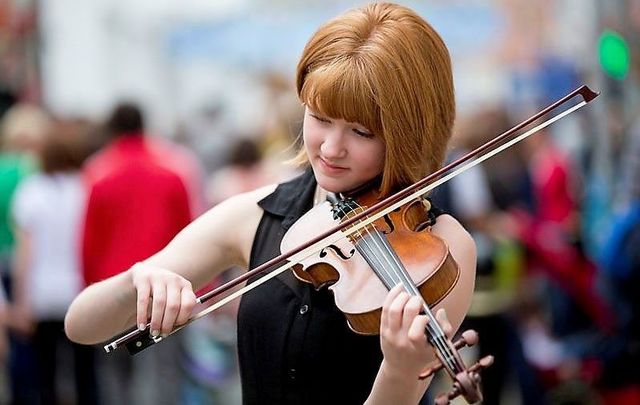Irish traditional music is among the most popular World Music genres of our time. Performed by Irish and non-Irish musicians throughout the world and patronized by audiences in diverse social and cultural settings, this ancient yet modern art is one of Ireland’s most enduring and defining cultural products.
Originally published in Ireland of the Welcomes Magazine, in the July / August 2017 issue. Subscribe now to our sister publication printed six times annually
Although Irish music’s eponymous home on the island of Ireland is still its creative center of gravity, this genre has expanded far beyond its ethnic, regional, and national origins.
In 1855, the music collector George Petrie wrote that “the music of Ireland has hitherto been the exclusive property of the peasantry. The upper classes are a different race – a race who possess no national music; or, if any, one essentially different from that of Ireland. They are insensitive to its beauty, for it breathed not their feelings; and they resigned it to those from whom they took everything else. He who would add to the stock of Irish melody must seek it, not in the halls of the great, but in the cabins of the poor.”
The Great Irish Famine (1845–1852), which provided the context for Petrie’s observation, had a devastating impact on the topography of Irish traditional music, as well as the music makers who maintained it. In its wake, the diaspora carried Irish music and song well beyond the rural cabins where Petrie transcribed during the middle decades of the nineteenth century. Since then, it has put down roots in the towns and cities of Ireland, and in Irish and non-Irish communities in North America, South America, Europe, and Australasia. Its intriguing dispersal from the kitchens and crossroads of the West of Ireland to the concert halls and recording studios of the New World has been propelled further by revolutions in mass media, popular culture, and international travel. While their music may be traced to a rural dialect, a traveling piper, a faded manuscript, or an old gramophone record, Irish traditional musicians today command the avid attention of vast transnational audiences.
There is no ironclad definition of Irish traditional music. It is best understood as a broad-based genre, which accommodates a complex process of musical convergence, coalescence, and innovation over time. It involves different types of singing, dancing, and instrumental music developed by Irish people at home and abroad over the course of several centuries. Irish traditional music is essentially oral in character and is transmitted from one generation to the next through a process of performance. Experienced musicians are capable of memorizing up to five hundred pieces of music, some of which they play regularly, while others may lie dormant for years. While traditional music has developed largely beyond the literate process, much of it has been written down. Some performers learn formally from written sources, as well as informally from experienced players. Others learn from radio, television, sound recordings, and the Internet. Although its repertoire may seem conservative in form, the oral base of Irish traditional music allows it to be more fluid than written music.

A proper Irish session in Co Galway.
Although some musicians and singers are folk composers in their own right, not all new compositions are accepted as part of the living tradition. When they are, the original composer is often forgotten and his or her ‘compositions’ absorb the influence of different dialects, instruments, and musicians. Hence the multiplicity of versions of well-known dance tunes and songs that is commonplace in Irish music. Within the bounds of the established tradition, experienced performers use improvisation in their interpretation of tunes, songs, and dances. This involves ornamenting and varying the basic melodic structures in dance music, as well as in traditional songs. Most musicians refer to their music as ‘traditional music’ or ‘Irish music’. The term ‘folk music’ is only used on occasion, while vague generic labels like Celtic Music, World Music, and market-driven typologies like Celtic Fusion, Afro-Celt, and Ethno Pop enjoy little currency among traditional performers.
Three interlocking traditions
In older rural communities in the West of Ireland, music usually followed the work cycle of the agricultural year. Festivities began with the Wrenboy celebrations on St Stephen’s Day (shortly after midwinter), continued through the matchmaking and weddings of Shrove (which often involved four or five house dances), and on into the sowing and harvest seasons, until the work cycle began again. Traditional music today has moved beyond this older cyclical milieu and may be heard at diverse social gatherings, pub sessions, dances, concerts, and festivals in various urban settings.
Irish instrumental music is sometimes referred to in terms of regional styles. A fiddler may be described as having a Sligo, Clare, or Donegal style. While these simplistic county divisions are partially valid, research among rural communities, especially in the West of Ireland, has revealed a more precise topography of musical dialects. Many of these are based on older clachan-type communities (rural clusters of extended kin and neighbors) that have remained intact since the post-famine era and are distinguished by specific dance rhythms, tune repertoires, and other stylistic features preserved by prominent performers and musical families.

Traditional Irish music.
The most common dance tunes in the Irish tradition are reels, jigs, hornpipes, polkas, slides, mazourkas, and highlands. Slow airs (usually based on sean nós songs in Irish) are also played by many instrumentalists. These sound most authentic when played on uilleann pipes, fiddle, flute or tin whistle. Dance tunes usually consist of two eight-bar segments, which older musicians refer to as ‘the first part’ and ‘the turn’. Each part is played twice through and the sequence is repeated twice (or three times) before changing into a new tune.
Most dance tunes in the Irish tradition date from the eighteenth and nineteenth centuries. They are played on various wind, string, and free-reed instruments, including flute, tin whistle, uilleann pipes, fiddle, concertina, and accordion. With the exception of the goat-skin bodhrán (a traditional drum played with a stick) and drums used in céilí bands, percussion instruments are of minor importance. Some of the most important developments in Irish fiddle music during the 20th century took place in the United States, which, by 1920, had become a creative center of Irish traditional music. The key patriarchs of this movement were Sligo fiddlers Michael Coleman, James Morrison, and Paddy Killoran. In Ireland, fiddlers Tommy Potts, Johnny Doherty, Paddy Canny, and Denis Murphy were responsible for some unique regional and stylistic contributions to their genre. Piping in contemporary Ireland has been shaped ostensibly by the playing of Séamus Ennis and Willie Clancy. Their styles are endemic today. Flute and whistle playing has been influenced by the recordings of John McKenna, John Joe Gardiner, and Tom McHale, who in turn inspired other performers.
Accordions and concertinas have been the most prominent melody instruments in Irish traditional music since the 1950s. The banjo (originally an African instrument, brought to America during the slave trade) has also made its presence felt in Irish traditional music, especially in the hands of Barney McKenna. Harpers have spurred a renaissance in Irish harp music. Other instruments have also been brought into the Irish musical fold, among them the piano, mouth organ, and piano accordion. Despite the obvious antiquity of the dance music, celebrated folk composers like Paddy Fahey and Martin Mulhaire continue to write new tunes. Lilting (portaireacht) or mouth music – once used for dancers in the absence of instruments at country house dances – has also regained its status in recent years.
The song tradition in Ireland is determined largely by the two linguistic cultures on the island. The most archaic form is sean nós (old style) singing in the Irish language. Each regional dialect of Irish has its own unique sean nós style. A complex and magnificent art, sean nós is an unaccompanied form of singing which demands tremendous skill and artistic understanding. It derives in part from the bardic tradition of professional poetry, which declined in the seventeenth century. There is no display of emotion or dramatics in sean nós. The singer is expected to vary each verse using improvisation, an implicit musical skill that requires subtle changes in rhythm, ornamentation, and timbre.
The transition from Irish to English language was marked by the growth of bilingual macaronic songs, many of which still survive. There are two categories of songs in English: English and Scottish songs, and Anglo-Irish songs. The first was introduced to Ireland by English and Scottish settlers in the seventeenth century, and by Irish migrant workers. This genre, which includes classic ballads like Lord Baker and Barbara Allen, is still popular in Ulster. Anglo-Irish songs were composed by Irish people whose mother tongue was English. These songs address the themes of love, courtship, emigration, politics, elopements, and other topics of human interest. Apart from these secular songs, a unique body of carols survives in the village of Kilmore Quay, Co Wexford. It dates from the seventeenth century and derives from a corpus of songs published by Luke Wadding in Ghent in 1684, as well as a manuscript collection compiled by William Devereux in Wexford in 1734.
There are few written accounts of dancing in Ireland before the 18th century. Foreign travelers have left references to the Irish hey, as well as the sword dance, round dance, and long dance. The English geographer Arthur Young left a colorful account of the Irish dancing master in the 1770s. Since then, Irish dancing has morphed into three distinct traditions, namely set dancing, céilí dancing, and step dancing, each of which has cross-cultural cognates in North America. Michael Flatley’s theatrical extravaganza Lord of the Dance, for example, derives much of its material from the formulaic step dancing initiated by Gaelic League revivalists in the late 19th century.
Since the spectacular emergence of Riverdance in 1994, Irish traditional music, song, and dance have received considerable media attention worldwide.
Other touring performers, new trends in Irish music education (formal and informal), and Internet sociology have also expanded the patronage and topographies of these genres. Despite this acclaim, however, the vast transcultural history of Irish traditional music remains obscured by narrow research agendas and binary debates about tradition and innovation – that frequently fail to explore the full gamut of Irish music memory and historiography. The purpose of this book, therefore, is to shed further light on this immense reserve of Irish cultural history, to acknowledge the music makers who sustain it, and to delight in the enduring success of their traditions at home and abroad.
*The above is an extract from "A Short History of Irish Traditional Music", by Gearóid Ó hAllmhuráin.
Originally published in Ireland of the Welcomes Magazine, in the July / August 2017 issue. Subscribe now to our sister publication printed six times annually
Read more

Love Irish history? Share your favorite stories with other history buffs in the IrishCentral History Facebook group.




Comments